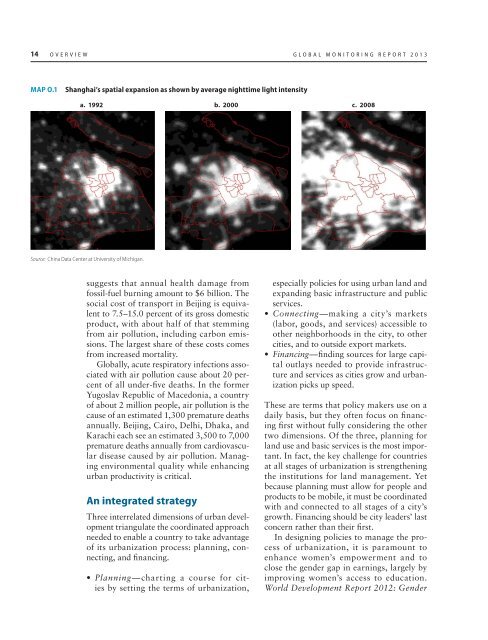rural-urban dynamics_report.pdf - Khazar University
rural-urban dynamics_report.pdf - Khazar University
rural-urban dynamics_report.pdf - Khazar University
Create successful ePaper yourself
Turn your PDF publications into a flip-book with our unique Google optimized e-Paper software.
14 OVERVIEW GLOBAL MONITORING REPORT 2013<br />
MAP O.1<br />
Shanghai’s spatial expansion as shown by average nighttime light intensity<br />
a. 1992 b. 2000 c. 2008<br />
Source: China Data Center at <strong>University</strong> of Michigan.<br />
suggests that annual health damage from<br />
fossil-fuel burning amount to $6 billion. The<br />
social cost of transport in Beijing is equivalent<br />
to 7.5–15.0 percent of its gross domestic<br />
product, with about half of that stemming<br />
from air pollution, including carbon emissions.<br />
The largest share of these costs comes<br />
from increased mortality.<br />
Globally, acute respiratory infections associated<br />
with air pollution cause about 20 percent<br />
of all under-five deaths. In the former<br />
Yugoslav Republic of Macedonia, a country<br />
of about 2 million people, air pollution is the<br />
cause of an estimated 1,300 premature deaths<br />
annually. Beijing, Cairo, Delhi, Dhaka, and<br />
Karachi each see an estimated 3,500 to 7,000<br />
premature deaths annually from cardiovascular<br />
disease caused by air pollution. Managing<br />
environmental quality while enhancing<br />
<strong>urban</strong> productivity is critical.<br />
An integrated strategy<br />
Three interrelated dimensions of <strong>urban</strong> development<br />
triangulate the coordinated approach<br />
needed to enable a country to take advantage<br />
of its <strong>urban</strong>ization process: planning, connecting,<br />
and financing.<br />
• Planning—charting a course for cities<br />
by setting the terms of <strong>urban</strong>ization,<br />
especially policies for using <strong>urban</strong> land and<br />
expanding basic infrastructure and public<br />
services.<br />
• Connecting—making a city’s markets<br />
(labor, goods, and services) accessible to<br />
other neighborhoods in the city, to other<br />
cities, and to outside export markets.<br />
• Financing—finding sources for large capital<br />
outlays needed to provide infrastructure<br />
and services as cities grow and <strong>urban</strong>ization<br />
picks up speed.<br />
These are terms that policy makers use on a<br />
daily basis, but they often focus on financing<br />
first without fully considering the other<br />
two dimensions. Of the three, planning for<br />
land use and basic services is the most important.<br />
In fact, the key challenge for countries<br />
at all stages of <strong>urban</strong>ization is strengthening<br />
the institutions for land management. Yet<br />
because planning must allow for people and<br />
products to be mobile, it must be coordinated<br />
with and connected to all stages of a city’s<br />
growth. Financing should be city leaders’ last<br />
concern rather than their first.<br />
In designing policies to manage the process<br />
of <strong>urban</strong>ization, it is paramount to<br />
enhance women’s empowerment and to<br />
close the gender gap in earnings, largely by<br />
improving women’s access to education.<br />
World Development Report 2012: Gender

















